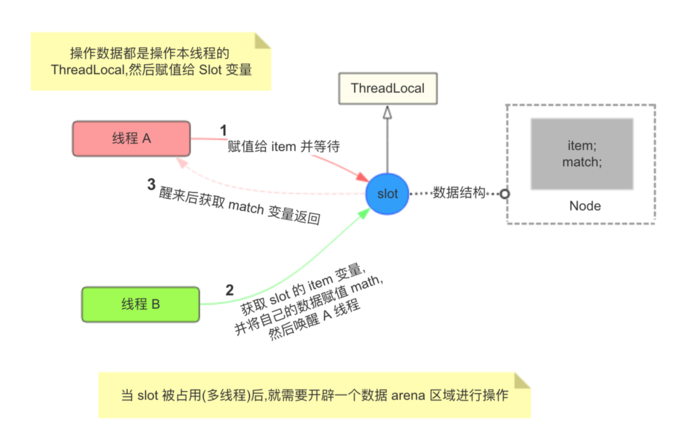Exchanger
Exchanger是一个用于线程间交换数据的工具类,它会提供一个同步点,两个线程在这个同步点处交换数据。如果第一个线程调用exchanger方法,它会一直在此等待,直到第二个线程也进入exchanger方法,两个线程在里面交换数据,之后再各自运行下去。它可以用于遗传算法,管道设计,或者其他需要对两个线程的数据进行校对的工作。
用法示例
下面通过JDK的一个示例来看看Exchanger该如何使用,然后再通过源码分析一下它的原理。示例代码如下:
1 | class FillAndEmpty { |
可以看到示例中起了两个线程,并通过共享的Exchanger变量来交换它们各自的buffer数据。下面我们通过源码来看看Exchanger数据交换的原理。
源码分析
Exchanger最核心的就是一个exchange方法,在分析这个方法之前我们先看一下Exchanger的成员变量和构造函数。
成员变量:
1 | /** |
Exchanger的成员变量主要是上面这几个,其中Participant和Node都是Exchanger的内部类,Node用于存储具体的数据,Participant继承于ThreadLocal,用于存储Node。可以看到上面存在一个Node类型变量,还有一个Node数组,这里就区分了两种情况——竞争情况下和非竞争情况下。bound是用于计算arena中具体的槽位的。
下面看一下Exchanger的构造函数。它的源码如下:
1 | /** |
Exchanger只有上面这一个构造函数,可以看到它其实只是创建了一个Participant。
下面看一下Exchanger的两个内部类,它们的源码如下:
1 | /** |
1 | /** The corresponding thread local class */ |
Participant主要就是用于存储线程本地的Node节点,不在多说,这里主要说下Node。它的内部属性注释也有说明,读者如果现在对这些属性的作用不明白也不要紧,在后面我们分析过exchange方法后,再回来看就能明白这些属性的作用了。我们这里看下这个@sun.misc.Contended注解,注释上说它可以减少竞争,那么到底是如何减少的呢?这里就要说一下Java并发中的一些底层知识。我们明白多线程一般在多CPU中才能更好的发挥性能,而在这些多CPU的机器中(事实上现在计算机基本都是多CPU)内存是共享的,而每个CPU还会有自己的本地缓存,缓存的基本单位就是缓存行CacheLine。现代CPU保证了对CacheLine的读写是原子的,每个CacheLine存储的数据是64bit,而在现在的英特尔酷睿等这些CPU是不支持部分填充缓存行的。这就是说如果一个缓存行没有填满,那么下一个连续的数据还会继续从这个缓存行开始填充。这样就会造成一个问题,当我在对第一个数据进行写入时,CPU会锁住这个缓存行,那么对第二个数据的读写操作就没法进行,因为它有部分数据和第一个数据共用了缓存行。因此为了避免这种情况,在Java中的一个办法就是填充无用字节,使连续的两个数据结构不存在共有缓存行的情况,即是空间换时间的一种妥协,有效的减少了竞争的情况。
下面看一下Exchanger中唯一的发布方法,它有两个版本,如下:
1 | public V exchange(V x) throws InterruptedException |
可以看到不同之处在于第二个增加了个超时时间,事实上很多并发类中的方法都会 有这么一个重载版本。这里我们只拿其中的第一个来介绍,来理解Exchanger的内部逻辑。它的源码如下:
1 | public V exchange(V x) throws InterruptedException { |
可以看到这段代码里主要逻辑是if条件的判断,通过&&符号连接了两个条件。主要逻辑是首先判断arena是否为null,如果为null,执行后面的slotExchange方法;如果arena不为空,则后面的slotExchange方法被短路,继续判断第二个条件,如果当前线程没有中断,则执行arenaExchange。回想之前的构造函数,其中并没有对arena的初始化,所以第一次进入这个方法,arena是为null的。下面看一下slotExchange方法。
1 | /** |
这个方法有些长,而且逻辑也很复杂,因为这个方法并不是独占的,需要考虑多线程的情况。这里我们假使只有两个线程进入到上面这个方法,通过分析他们的执行路劲,来看一看数据是如何交换的。
第一个线程首次进入,首先从participant中得到一个Node变量,这个get方法的调用路径最终会走到Participant中重写的initialValue方法。然后会进入一个for循环,因为是第一次进入slot为null,它会被路由到最后一个else块中。(其中对arena的校验条件是为了兼容多线程的情况,因为此时arena可能还没有被创建,而前面exchange方法中的条件又不是原子的,存在其他线程执行到这里,而arena刚好被创建的情况)继续看看这个else块里做了啥,可以看到它把当前线程持有的数据item塞进了Node中,并通过CAS操作将这个Node变量的值设给成员变量slot,这里要记住一点,这个slot变量是线程共享的。然后就跳出了循环,继续执行。
下面还是一个循环,直到match中有值为止,或者中断,超时,arena被赋予了值;否则,线程将在循环中自旋,自旋的值在多核情况下默认是1024,自旋结束后且此时slot仍然等于p,则线程挂起等待被其他线程唤醒。好的,第一个线程走到这里挂起了,下面我们看看第二个线程。
此时第二个线程进来,slot已经不是null了,所以它会进入第一个if块。在这个语句块中将slot的值置为null,并取出slot中item返回,这个item其实第一个线程携带的数据;而当前线程会将自己携带的数据item放入match中,唤醒之前阻塞的线程。
而第一个线程被唤醒后,此时match有值,它会跳出循环,继续往下执行。将match也设为空,还原现场,只有这个hash值会被复用,最后返回这个match值。
所以我们看到所谓的交换数据,只是通过一个共享的Node类型变量,分别将数据放入它的item和match中,最后返回各自需要的数据。如果只是两个线程的话,整体流程并不复杂,但是因为需要考虑多线程环境下的情况,徒增了很多复杂性。并且在高并发的情况下,可能会存在对这个Node变量争用的情况,因为这个Node是唯一的,所以作者又提供一个争用版本,即arenaExchange方法,采用了一个Node数组来规避竞争,而竞争发生后,所有进入到slotExchange方法的线程会被路由的到arenaExchange方法里。arenaExchange方法的源码如下:
1 | /** |
这个方法笔者这里就不再分析了,一是由于它更加复杂,笔者很多地方也没有弄明白,不能误人子弟;二是我们理解了它的线程间数据交换的机制也已足够,毕竟这个类使用的情况并不多,也多是在两个线程之间的调用,没有必要对它理解的十分透彻。当然感兴趣的读者,也可以仔细分析下这个方法。
总结
Exchanger就分析到这了,笔者本身源码也看的磕磕碰碰,很多地方都不是太明白,也有很多地方没有说到。读者若有些不懂得地方可以再看一看其他的博客,最后自己仔细研读下源码,可能会比笔者理解的更加透彻。下面通过一幅笔者从网上盗的图结束这篇博客。这幅图盗于简书的一片博客,笔者实在懒得画图,见谅见谅。该篇博文的地址为那篇博客
